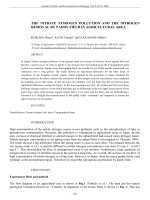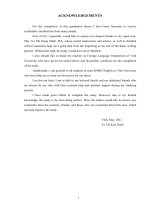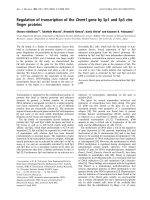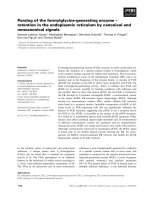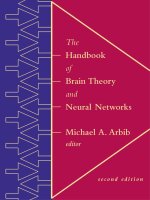the handbook pragmatics by horn and ward
Bạn đang xem bản rút gọn của tài liệu. Xem và tải ngay bản đầy đủ của tài liệu tại đây (4.25 MB, 864 trang )
The Handbook of
Pragmatics
Edited by
Laurence R. Horn and
Gregory Ward
“It takes erudition, vision, and good taste to compile a good handbook of
any field, even more so in the notoriously unruly field of pragmatics. Larry
Horn and Gregory Ward have all of these. The editors have gathered
together an excellent array of contributors to give us a handbook that will
prove eminently useful to scholars and students within and outside
pragmatics. Readers will find in it a reliable guide to the main pragmatic
questions of the last three decades, which is insightful, u p to date,
authoritative, and accessible.”
Mira Ariel, Tel Aviv University
Blackwell Handbooks in Linguistics
This outstanding multi-volume series covers all the malor subdisciplines within
linguistics today and, when cornplctc, will offcr a comprehensive survey of Itnguistics
as a whole.
Already published:
The Handbook of Child Language
Edited by Paul Fletcher and Brian
Mac Whinncy
The Handbook otlanguagc and Colder
Edited by Janet Holmes and Miriam
Meyerhoff
T h e Handbook of Phonological 7heory
Edited by John A. Goldsmith
The Handbook of Second Language
Acquisit ion
Edited by Catherine J. Doughty and
Michael H. Long
The Handbook of Conkmporary Semantic
nit-ory
Editcd by Shalom Lappin
The Handbook of Sociolinguistics
Edited by Florian Coulmas
7% Handbook of Phonetic Sciences
Edited by William J. Hardca5tle and John
Laver
The Handbook of Morphology
Edited by Andrew Spencer and Arnold
Zwicky
The Handbook of/apatrese Linguistics
Edited by Natsuko Tsujimura
7he Handbook of Linguistics
Edited by Mark Aronoff and Janie ReesMiller
The Hundbook ojConlemporary Syntactic
Theory
Edited by Mark Baltin and Chris Collins
7he Handbook of Discourse Analysis
Edited by Deborah Schiffrin, Ueborah
Tannen, and Heidi E. Hamilton
The tlnndbnok of langimge Variation a n d
Change
Edited by J. K . Chambers, Peter Trudgill,
and Natalie Schilling-Estes
The Handbook ojHistorical Linguistics
Edited by Brian D. Joseph and Richard D
Janda
The Hnndbook of Brlingualiqm
Edited by Tcj K Bhatia and William C.
Ritchie
The Handbook ofPragmatrcs
Edited by Laurence R. Horn and Gregory
Ward
The Handbook of Applied Liuguisfics
Edited by Alan Davies and Catherine
Elder
Tht Handbook of Speech k r c p f i o n
Edited by David B Piboru and Robert E
Kcmez
Thhp B l a c k w l l Companion to Syntax,
Volume5 I-V
Edited by Martin Everaert and Hcnk van
Riemsdijk
The Handbook ofthe History of Enylidl
Edited by An5 van Kemenade and
Bettelou Los
The Handbook Gf€nglish Linguistics
Edited by Bas Aarts and April McMahon
Thr Handbook of W u r l d Englishzs
Edited by Bra] 8.Kachm; Yamuna
Kachru, Cecil L Nelso
The Handbook of
Pragmatics
Edited by
Laurence R. Horn and
Gregory Ward
02004,2006 bv Blackwell Publishing I.td
Rl.ACKWELI. PUBLLSIflNC
350 Main Strcet, Maldcn. MA 02 14s 5020. USA
9600 Carsington Road, Oxford OX4 2DQ. UK
550 Swaiialun Strcct, Carlton. Victoria 3053. Australia
Thr right of Laurence K llorn and Gregory Ward to be identified as thc Aulliors uf the Cditorial
Matenal in this Work has k e n asserted in accordance with the UK Copyright, Designs. and
Patents Act 1988
All rights reervcd. N o part of this publitation may be rcproduccd, ztored in a retncval bystern.
or transmitted, in any form or by any mcans. elcctronir, mwhdnical. photocopying. recording or
otherwisc. except as permitted by the UK Copyright, Designs, and Patents Act 1988, wlthout the
prior permissinn of the publisher
First published 2004 by Ulackwell Publishmg Ltd
First published in paperback 2006 by [Ilackwell Publizhing Ltd
1 2006
Library o f C o n p s s Cafaloging
in
Publication U ~ t o
1 he handbook of pragmatic31 edited by Laurence R Hurii and Gregory
Ward.
p cm. - (Blackwell handbooks in linguistics. 16)
Includes bibliographical referent-.
ISBN 0-631.22547.1 (alk paper)
1 Pragnahcs 1 I lorn. Laurence R I1 Ward, Cregory L 111 Srwcs
IY9.4.P721135 2004
306.44 - dc22
2003016284
ISBN-13.9780-631.22547.8 (alk paper)
ISBN 13 978 0-631 22548.5 (paperback)
ISI
Acataloguc rccord for this title is a v a h b l e from
the
Bntihh I ihrary
Set in 10112 pt Palatlno
by Graphcraft Ltd. Iiong Kong
Pnnted and bound in the United Kingdom
by Tj International, Padstow. Cornwall
The publisher's p l i r v is to uqe pcrmmcnt pAper from mills that operate a sustainable forestry
policy. and which has been manufactured from pulp processed using acid.frw and rlemcntary
cliluriiidree practiccs Furthermore, the publisher ensures that the t e x t paper and cnver board
used have met arreptable environmental accreditation standards
I b r further information on
Blackwell Publistung. visit our website
www blackwellpublishing com
Contents
List of Contributors
Introduction
I
The Domain of Pragmatics
viii
xi
1
1.
Implicature
Laurence R. Horn
2.
Presupposition
Jay David Atlas
29
3.
Speech Acts
Jerrold Sadock
53
4.
Reference
Gregory Carlson
74
5.
Deixis
Stephen C. Levinson
97
6.
Definiteness and Indefiniteness
Barbara Abbott
II
Pragmatics and Discourse Structure
3
122
151
7.
Information Structure and Non-canonical Syntax
Gregory Ward and Betty Birner
153
8.
Topic and Focus
Jeanette K. Gundel and Thorstein Fretheim
175
9.
Context in Dynamic Interpretation
Craige Roberts
197
vi Contents
10.
Discourse Markers
Diane Blakemore
221
11.
Discourse Coherence
Andrew Kehler
241
12.
The Pragmatics of Non-sentences
Robert J. Stainton
266
13.
Anaphora and the Pragmatics–Syntax Interface
Yan Huang
288
14.
Empathy and Direct Discourse Perspectives
Susumu Kuno
315
15.
The Pragmatics of Deferred Interpretation
Geoffrey Nunberg
344
16.
Pragmatics of Language Performance
Herbert H. Clark
365
17.
Constraints on Ellipsis and Event Reference
Andrew Kehler and Gregory Ward
383
III Pragmatics and its Interfaces
405
18.
Some Interactions of Pragmatics and Grammar
Georgia M. Green
407
19.
Pragmatics and Argument Structure
Adele E. Goldberg
427
20.
Pragmatics and Semantics
François Recanati
442
21.
Pragmatics and the Philosophy of Language
Kent Bach
463
22.
Pragmatics and the Lexicon
Reinhard Blutner
488
23.
Pragmatics and Intonation
Julia Hirschberg
515
24.
Historical Pragmatics
Elizabeth Closs Traugott
538
25.
Pragmatics and Language Acquisition
Eve V. Clark
562
26.
Pragmatics and Computational Linguistics
Daniel Jurafsky
578
Contents
vii
IV Pragmatics and Cognition
605
27.
Relevance Theory
Deirdre Wilson and Dan Sperber
607
28.
Relevance Theory and the Saying/Implicating Distinction
Robyn Carston
633
29.
Pragmatics and Cognitive Linguistics
Gilles Fauconnier
657
30.
Pragmatic Aspects of Grammatical Constructions
Paul Kay
675
31.
The Pragmatics of Polarity
Michael Israel
701
32.
Abduction in Natural Language Understanding
Jerry R. Hobbs
724
Bibliography
Index
742
820
Contributors
Barbara Abbott Michigan State University, East Lansing, Michigan
Pomona College, Claremont, California
Jay David Atlas
Kent Bach
San Francisco State University, San Francisco, California
Betty Birner Northern Illinois University De Kalb, Illinois
Diane Blakemore
University of Salford, Salford, UK
Reinhard Blutner
Humboldt University, Berlin Germany
Gregory Carlson University of Rochester, Rochester, New York
Robyn Carston
University College, London, UK
Eve V. Clark Stanford University, Stanford, California
Herbert H. Clark Stanford University, Stanford, California
Gilles Fauconnier University of California, San Diego, California
Thorstein Fretheim Norwegian University of Science and Technology,
Trondheim, Norway
Adele E. Goldberg Princeton University, Princeton, New Jersey
Georgia M. Green
University of Illinois, Urbana, Illinois
Jeanette K. Gundel University of Minnesota, Minneapolis, Minnesota
Julia Hirschberg Columbia University, New York
Jerry R. Hobbs Information Sciences Institute, University of Southern
California, Los Angeles, California
Laurence R. Horn Yale University, New Haven, Connecticut
Yan Huang
University of Reading, Reading, UK
Contributors
Michael Israel
University of Maryland, College Park, Maryland
Daniel Jurafsky Stanford University, Stanford, California
Paul Kay University of California, Berkeley, California
Andrew Kehler University of California, San Diego, California
Susumu Kuno Harvard University, Cambridge, Massachusetts
Stephen C. Levinson Max-Planck Institute, Nijmegen, the Netherlands
Geoffrey Nunberg Stanford University, Stanford, California
François Recanati
Institut Jean Nicod (CNRS), Paris, France
Craige Roberts Ohio State University, Columbus, Ohio
Jerrold Sadock University of Chicago, Chicago, Illinois
Dan Sperber
CREA, Paris, France
Robert J. Stainton University of Western Ontario, London, Ontario
Elizabeth Closs Traugott Stanford University, Stanford, California
Gregory Ward Northwestern University, Evanston, Illinois
Deirdre Wilson University College, London, UK
ix
Introduction
Pragmatics as a field of linguistic inquiry was initiated in the 1930s by Morris,
Carnap, and Peirce, for whom syntax addressed the formal relations of signs to
one another, semantics the relation of signs to what they denote, and pragmatics
the relation of signs to their users and interpreters (Morris 1938). In this program, pragmatics is the study of those context-dependent aspects of meaning
which are systematically abstracted away from in the construction of content
or logical form.
The landmark event in the development of a systematic framework for pragmatics was the delivery of Grice’s (1967) William James lectures, a masterful
(if incomplete) program that showed how a regimented account of language
use facilitates a simpler, more elegant description of language structure. Since
then, a primary goal of pragmatics has been the one reflected in Bar-Hillel’s
celebrated warning (1971: 405): “Be careful with forcing bits and pieces you
find in the pragmatic wastebasket into your favorite syntactico-semantic theory.
It would perhaps be preferable to first bring some order into the contents of
this wastebasket.” More recently, work in pragmatic theory has extended from
the attempt to rescue syntax and semantics from their own unnecessary complexities to other domains of linguistic inquiry, ranging from historical linguistics to the lexicon, from language acquisition to computational linguistics,
from intonational structure to cognitive science.
In this Handbook, we have attempted to address both the traditional and
the extended goals of theoretical and empirical pragmatics. It should be noted,
however, that other traditions – especially among European scholars – tend to
employ a broader and more sociological conception of pragmatics that encompasses all aspects of language use not falling strictly within formal linguistic
theory; see for example the entries in Verschueren et al. (1995) and Mey (1998)
and, for a more restricted view, Moeschler and Reboul (1994). For reasons of
space and coherence of presentation, we have largely restricted our coverage
to the more narrowly circumscribed, mainly Anglo-American conception of
linguistic and philosophical pragmatics and its applications.
xii Introduction
The Handbook is divided into four parts. Part I contains overviews of the
basic subfields within pragmatic theory: implicature, presupposition, speech
acts, reference, deixis, and (in)definiteness. The domain of discourse, and in
particular the structuring of information within and across sentences, is the
focus of the chapters in part II. The chapters in part III concentrate on the
interfaces between pragmatics and other areas of study, while those in part IV
examine the role of pragmatics in cognitive theory.
For centuries before the field had a label or identity, pragmatics as we now
understand it has radiated outward from that aspect of human inferential
behavior Grice calls implicature, the aspect of speaker meaning that distinguishes what is (strictly) said from what is (more broadly) meant. The character of conversational implicature is surveyed in Larry Horn’s chapter, which
explores the relation of implicature to propositional content and linguistic
form.
In addition to implicature, the realm of pragmatic inference notably encompasses presupposition. While a semantic presupposition is a necessary condition on the truth or falsity of statements (Frege 1892, Strawson 1950; see also
Beaver 1997 and Soames 1989), a pragmatic presupposition is a restriction on
the common ground, the set of propositions constituting the ongoing discourse
context. Its non-satisfaction results not in the emergence of truth-value gaps
but in the inappropriateness of a given utterance in a given context (Karttunen
1974, Stalnaker 1974). In asserting p, I propose adding the propositional content of p to the common ground; in presupposing q, I treat q as already (and
non-controversially) part of the common ground. But, as observed by Stalnaker
(1974) and Lewis (1979), a speaker may treat q as part of the common ground
even when it actually isn’t, through the principle of accommodation. In his
contribution to this volume, Jay Atlas focuses on accommodation and noncontroversiality as the keys to the neo-Gricean theory of presupposition.
If pragmatics is “the study of linguistic acts and the contexts in which they
are performed” (Stalnaker 1972: 383), speech act theory – elaborating the distinction between the propositional content and the illocutionary force of a
given utterance – constitutes a central subdomain, along with the analysis of
explicit performative utterances and indirect speech acts. Speech act theory
has evolved considerably from the early work initiated by Austin and Searle,
as is discussed in Jerry Sadock’s chapter.
While speech acts and presuppositions operate primarily on the propositional
level, reference operates on the phrasal level. Reference involves a speaker’s
use of linguistic expressions (typically NPs) to induce a hearer to access or
create some entity in his mental model of the discourse. A discourse entity
represents the referent of a linguistic expression, i.e. the actual individual (or
event, property, relation, situation, etc.) that the speaker has in mind and is
saying something about. The relation between the expressions uttered by a
speaker (and the demonstrative gestures that may accompany them) and what
they do or can denote presents a range of problems for semantics, pragmatics,
and psychology. Greg Carlson’s chapter on reference surveys this important
Introduction xiii
domain, while other contributions to the Handbook (cf., for example, the chapters by Nunberg and by Kehler and Ward in part II) revisit specific aspects of
the issues raised here.
One persistent complication for any theory of reference is the ubiquity of
deictic or indexical expressions. From its inception, a central goal of pragmatics
has been to “characterize the features of the speech context which help determine which proposition is expressed by a given sentence” (Stalnaker 1972:
383). The meaning of a sentence can be regarded as a function from a context
into a proposition, where a proposition is a function from a possible world
into a truth value; pragmatic aspects of meaning include the relation between
the context in which an utterance is made and the proposition expressed by
that utterance. Deixis characterizes the properties of expressions like I, you,
here, there, now, hereby, tense/aspect markers, etc., whose meanings are constant but whose referents vary with the speaker and hearer, the time and place
of utterance, and the style, register, or purpose of the speech act. This is
explored in the chapter contributed by Steve Levinson, which examines in
detail the nature of cross-linguistic variation within the deictic domain.
Another issue within the overall account of reference is the choice among
referring expressions and in particular the notion of definiteness, which has
been defined both as a formal marking of NPs and as an information status
(see chapters in part II). The felicitous use of definite expressions has been
pegged to the requirement that the referent of the NP be either familiar within
the discourse or uniquely identifiable to the hearer. The other side of this coin
is indefiniteness, which has typically been associated with novelty (as opposed
to familiarity) or with non-uniqueness. These issues are investigated in Barbara
Abbott’s chapter, which concludes part I of the Handbook.
The chapters in part II focus on context-dependent aspects of meaning that
arise within discourse, in particular the structuring of information within
and across sentences. The starting point for work in this area is the now
well-established principle that speakers structure their discourse by taking
into account both the (assumed) belief states and attentional states of their
addressees.
The lead-off chapter by Gregory Ward and Betty Birner examines the role
that non-canonical syntactic constructions play in the construction and processing of a coherent discourse. One of the key factors contributing to the
coherence of a discourse is the existence of informational links among utterances within the discourse. Ward and Birner show how speakers’ use of noncanonical word order marks the information status of these links across
sentences while at the same time facilitating discourse processing through the
strategic placement of information in different syntactic positions.
At the heart of information structure since the seminal work of the Prague
School in the 1930s are the interrelated notions of topic or theme (what a given
statement is about) and focus or rheme (what is predicated about the topic). In
their chapter, Jeanette Gundel and Thorstein Fretheim review the vast and
often confusing literature on these notions across various frameworks. They
xiv Introduction
take topic and focus to be essentially linguistic categories, irreducible to more
general cognitive or social principles. Moreover, they argue, a crucial distinction
must be made between those properties of topic and focus that are directly
attributable to the grammar and those that follow from purely pragmatic principles. Distinguishing between the grammatical and extragrammatical properties of topic and focus is crucial to the formulation of theories of discourse and
information structure and to a more adequate account of how the language
system interacts with general pragmatic principles governing language production and understanding.
At the heart of any comprehensive theory of the relation of an utterance’s
meaning to its context is a precise characterization of the very notion of context itself. As Craige Roberts points out in her chapter, an adequate theory of
discourse and discourse coherence requires that the relation holding between
a linguistic expression and its context of utterance be appropriately modeled
and continuously updated as the discourse unfolds. For Roberts, what is
necessary in order to model and track this relation is information about the
mutual intentions of the co-participants and how these intentions are interrelated. This information, coupled with an appropriate semantics and inference
engine, provides the basis for our understanding how context affects (i.e.
induces or constrains) utterance interpretation.
Diane Blakemore’s chapter focuses on discourse markers (DMs), also known
as discourse connectives or particles (well, so, but, and the like). DMs have
been characterized both negatively, by the non-truth-conditionality of their
contribution to meaning, and positively, by their role in highlighting coherence and connectivity among the units of a discourse. Blakemore sees the
distribution and interpretation of such markers as informing our understanding of the semantics–pragmatics interface and of the distinction between conceptual and procedural meaning. After evaluating the accounts of DMs offered
by speech act theory, traditional Gricean pragmatics, and argumentation theory,
Blakemore argues for a relevance-theoretic analysis of the contribution of these
expressions.
While Blakemore’s chapter outlines the role that discourse markers play in
establishing coherence, Andy Kehler’s chapter analyzes discourse coherence
in its own right. As Kehler observes, hearers do not generally interpret adjacent sentences within a discourse segment as independent and unrelated utterances. Rather, there is an expectation that statements are related in one of
several ways that can be captured by a small number of coherence relations.
Kehler categorizes these relations into three broad classes defined by basic
cognitive principles: cause–effect, contiguity, and resemblance. Kehler illustrates the crucial role that coherence relations play in language by examining
their influence on the interpretation of a wide range of disparate linguistic
phenomena, including VP-ellipsis, gapping, extraction from conjoined clauses,
and pronominal reference.
A long-standing challenge to sentence-based approaches to interpretation is
the fact that a speaker whose utterances are syntactically and semantically
Introduction
xv
subsentential may nevertheless manage to express complete propositions and
perform fully felicitous speech acts by means of such expressions. The chapter
by Rob Stainton on the pragmatics of non-sentences provides a cognitivepragmatic analysis consisting of two processes: decoding and unencapsulated
inference. According to Stainton, non-sentential utterances are first interpreted
by the linguistic decoder, which produces a subsentential mental representation.
This representation, in turn, is combined with another (non-decoder-derived)
mental representation to yield a fully sentential mental representation, which,
while not part of any natural language, nonetheless encodes the complete
message as intended by the speaker.
Yan Huang’s chapter investigates the extent to which the formal conditions
of classical binding theory can be supplanted by pragmatic principles. Following earlier work by Reinhart, Dowty, and especially Levinson, he argues
that the near-complementary distribution of pronominals and anaphors (i.e.
reflexives and reciprocals) and the cross-linguistic patterns of long-distance
anaphora and logophoric reference can best be accounted for if the syntax and
semantics of binding interacts with neo-Gricean pragmatic theory. As Huang
observes, the “soft constraints” built into the neo-Gricean analysis anticipates
recent Optimality-theoretic approaches to anaphora.
Another challenge to the self-sufficiency of grammatical theory for explaining linguistic phenomena is offered in Susumu Kuno’s chapter on empathy
and perspective. Empathy is the degree to which a speaker identifies with, or
takes the perspective of, a particular individual or entity referenced in a given
utterance. In this way, the same propositional content can be presented from
different points of view. Many apparently mysterious phenomena assumed to
be purely syntactic can be successfully accounted for only by appeal to these
quintessentially pragmatic notions. Kuno proposes that such perspectives
interact with syntactic principles in predictable ways and that it is only through
such an interaction of pragmatic and grammatical modes of explanation that a
full account of such linguistic phenomena as anaphora, logophoricity, and
passivization is possible.
Among the most creative but least well understood traits of colloquial discourse is the possibility of deferred reference, which occurs when an expression that conventionally picks out a given referent is used in a sufficiently rich
context to refer instead to a discourse entity associated with that referent, as
when a bartender refers to his customer as “the gin and tonic” or a doctor to
her patient as “the kidney transplant in 317.” In his chapter, Geoff Nunberg
treats deferred reference as an instance of meaning transfer applied to the
properties which linguistic expressions (NPs and predicates) supply. Nunberg
explores some of the pragmatic and non-pragmatic factors that constrain and
affect such transfers and figurative language more generally.
Herb Clark develops the (now uncontroversial) idea advanced by Grice, Lewis,
and others that language is a fundamentally cooperative venture. In this chapter, Clark argues for a pragmatic theory of language performance drawing on
two interrelated systems: a primary system of linguistic communication and
xvi Introduction
a collateral system that draws heavily on Clark’s notion of display. Speakers
display various signals to addressees that serve to indicate the speaker,
addressee, time, place, and content of the signal. The addressee, in turn,
signals receipt of the display by conveying acceptance of these indications.
Such feedback mechanisms are shown to be crucial to our understanding of
the communicative process.
Rounding out part II is Andy Kehler’s and Gregory Ward’s chapter on event
reference. Whereas most pragmatic accounts of the constraints associated with
particular referring expressions focus on reference to entities (see e.g. Carlson’s
chapter in part I), Kehler and Ward argue that such accounts need to be
revised and extended to account for event-level ellipsis and reference. Their
examination of four different event-referring constructions suggests that an
adequate model must ultimately appeal to a diverse set of properties that
govern natural language syntax, semantics, and pragmatics.
Part III offers varied perspectives on the major interfaces of pragmatics.
Linguists have long sought to rely on pragmatic theory to render their
accounts of grammatical phenomena both simpler and more explanatory. In
the early years of generative grammar, any appeal to pragmatics was seen as
hand-waving, less of an explanation of the phenomenon in question than an
excuse to avoid dealing with it. As our understanding of pragmatics has
deepened, so has our recognition of the ways in which it interacts with other
aspects of linguistic competence. Georgia Green’s chapter addresses some of
the more significant properties of the syntax–pragmatics interface, including
the role of context (encompassing speakers’ beliefs and intentions) in the
description of grammatical constructions and in the formulation of constraints
on grammatical processes.
Another investigation of the syntax–pragmatics interface is the chapter
by Adele Goldberg on argument structure. Goldberg shows that pragmatic
factors such as topic, focus, and information structure all play a crucial role
in determining whether a particular argument (or adjunct) is realized in the
syntax and, if so, where and in what form that argument appears. These
pragmatic factors interact with language-specific grammatical principles to
produce the variation in argument structure found cross-linguistically.
From the inception of the Peirce–Carnap–Morris trichotomy, one central
issue in the study of meaning has been the semantics/pragmatics distinction
and the proper treatment of the borderline defined by their interaction. This
territory is explored in the chapters by François Recanati and Kent Bach.
Recanati provides an overview of the domain, concentrating on the emergence
of modern pragmatics from the crucible of the conflict between formal
semanticists and ordinary language philosophers in the second half of the
twentieth century. As Recanati shows, current disputes on the role of pragmatic
processes in the determination of truth-conditional content and the treatment
of unarticulated constituents can be traced to the different responses urged by
Griceans and relevance theorists to the division of labor between semantics
and pragmatics in the treatment of meaning in natural language.
Introduction xvii
Bach’s chapter addresses two sets of problems: those for which the philosophy of language informs the study of pragmatics (e.g. the treatment of
performatives, speech acts, and implicature) and those for which pragmatics
informs the philosophy of language. In keeping with the Bar-Hillel wastebasket
apothegm, Bach repositions the line of demarcation between semantics and
pragmatics in a way that allows a significant range of traditional semantic
problems in the areas of reference, presupposition, quantification, and ambiguity to be resolved – or at least clarified – by the application of independently motivated pragmatic, i.e. communication- or use-based, principles and
processes.
The traditional syntax/semantics/pragmatics trichotomy extends from the
analysis of sentences and discourse into the lexicon. While the study of the
syntax and semantics of words (morphology and lexical semantics, respectively) are well-established disciplines, the last quarter century has witnessed
the development of the new field of lexical pragmatics. Reinhard Blutner’s
chapter is devoted to this field, focusing on pragmatically based constraints on
lexicalization (see also Horn’s implicature chapter), the role of pragmatic
strengthening, markedness asymmetries, and the non-monotonic character of
word meaning. (The diachronic aspects of these questions are treated in
Traugott’s chapter.) As Blutner shows, there is a natural kinship between a
neo-Gricean approach to the mental lexicon (dating back to McCawley 1978)
and current developments in bidirectional Optimality Theory, in which the
dialectic of speaker and hearer receives a natural representation.
As Julia Hirschberg points out in her chapter, intonational meaning is
essentially pragmatic in nature, as its interpretation crucially depends on contextual factors. Hirschberg brings together research from linguistics, speech,
computational linguistics, and psycholinguistics, applying a uniform notation
to describe the prosodic variation discussed in this work. Intonation is shown
to interact with syntax (attachment ambiguities), semantics (scope ambiguities, focus), and of course pragmatics (discourse and information structure,
pronominal reference, and speech act interpretation).
The last quarter century has seen the study of pragmatic aspects of meaning
change and lexicalization play an increasingly significant role within diachronic
linguistics. Both corpus-based and theoretical investigations have been enriched
by the recognition of the role of implicature in facilitating and constraining the
set of possible and likely varieties of change. The application of neo-Gricean
inference to lexical change is the focus of Elizabeth Traugott’s chapter on
historical pragmatics, which also explores the ways in which polysemy arises
and the routes by which non-literal aspects of meaning tend to become frozen
into the conventional value of a lexical expression.
Pragmatics plays a central role in ontogeny as well as phylogeny, as Eve
Clark’s chapter demonstrates. Clark explores the language learner’s acquisition
of the ability to tailor the form of utterances to the assumed requirements of
one’s conversational partners. In their application and eventual refinement of
the principle of contrast, their familiarization with the interactional principles
xviii
Introduction
of politeness and common ground, and their first steps toward the development of a working knowledge of implicature from both speaker’s and hearer’s
perspectives, children have set out on the road that will lead to full pragmatic
competence.
No survey of the interfaces of pragmatics would be complete without a
look at attempts to build machines that have the capacity to emulate human
pragmatic competence. As Dan Jurafsky notes in his chapter, computational
pragmatics is largely concerned with the modeling of the ability of humans to
infer information not explicitly realized in an utterance. Jurafsky focuses on
the interpretation and generation of speech acts as a case study of recent work
in this area.
In keeping with other sections of the Handbook, part IV is organized
thematically rather than doctrinally; the six papers it collects all deal with
the relation between pragmatics and cognition, while encompassing a variety
of distinct theoretical approaches. Deirdre Wilson, Dan Sperber, and Robyn
Carston have been major advocates of relevance theory, an influential revision
of the Gricean paradigm (Sperber and Wilson 1986a, Carston 2002b). Wilson
and Sperber present a state-of-the-art overview of RT, focusing on the implications of this approach for communication, utterance interpretation, and the
modular view of mental architecture, while also touching on the analysis of
irony and metarepresentation more generally. In her chapter, Carston reexamines the classic Gricean distinction between what is said and what is
implicated in the light of current developments in RT. She argues for a position in which “what is said,” a central construct in neo-Gricean work, in fact
plays no role within pragmatic theory, and in which the implicit/explicit
distinction is reconstructed in terms of the relevance-theoretic notion of
explicature, a pragmatically determined aspect of propositional content that
(contrary to implicature) is germane to the determination of truth conditions.
A different model of the pragmatics of cognition underlies work by Gilles
Fauconnier, the originator of the theory of mental spaces. In his chapter,
Fauconnier examines the relation between literal and metaphorical interpretation, and concludes that a direct assignment of meaning to grammatical constructions offers a more insightful approach than one mediated by a two-stage
Gricean analysis in which literal meaning serves as the input to metaphorical
reanalysis. Fauconnier extends the theory of mental spaces to the analysis of
opacity, presupposition, performatives, and scalar predication, surveying a
variety of ways in which recent developments in cognitive science are relevant
for research in pragmatics.
Another perspective on cognitive pragmatics is offered by Paul Kay, one of
the founders of Construction Grammar. After demonstrating the complexity
of the issues the hearer must sort out in the interaction of grammatical structure
and context or common ground as a prerequisite to interpretation, Kay surveys
a variety of domains in which pragmatic information influences grammatical
constructions, including indexicals, scalar models, metalinguistic operators,
hedges (kinda, sorta, technically), and speech acts.
Introduction xix
In his chapter, Michael Israel investigates one such class of constructions,
that comprising negative and positive polarity items. He shows how the lexical
properties and grammatical distribution of such items are intricately tied to
Kay’s notion of scalar model and to the pragmatic asymmetry of negation and
affirmation (Horn 1989). Like other essays in the volume, Israel’s discussion
also explores the important issue of how inherently pragmatic conditions become conventionalized into the lexicon and grammar.
A final look at the pragmatics/cognition interface is presented in the chapter
by Jerry Hobbs on abductive reasoning. Abduction, originally identified by
C. S. Peirce and more recently developed by researchers in artificial intelligence dealing with the non-monotonic nature of natural language inference, is
applied by Hobbs to a variety of problems of a pragmatic nature, ranging from
disambiguation and reference resolution to the interpretation of compound
nominals and the nature of discourse structure.
We conclude our introductory remarks with a heartfelt appreciation for the
efforts and perseverance of our contributors through the difficulties of the
editorial process; without them there would be no Handbook of Pragmatics. In
addition, we would like to thank Sarah Coleman and Tami Kaplan at Blackwell
for their support and hard work on our behalf. Finally, we extend a special
note of thanks to Kent Bach, Ann Bunger, and Bill Lachman for their editorial
assistance.
Part I The Domain of
Pragmatics
HH



